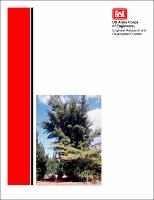Please use this identifier to cite or link to this item:
https://hdl.handle.net/11681/3315| Title: | Potential use of insect biocontrol agents for reducing the competitive ability of Hydrilla verticillata |
| Authors: | University of North Texas. Institute of Applied Sciences Lewisville Aquatic Ecosystem Research Facility Aquatic Plant Control Research Program (U.S.) Grodowitz, Michael Jay Doyle, Robert D. (Robert Donald) Smart, R. Michael |
| Keywords: | Biological control Integrated pest management Hydrilla Plant management Plant competition |
| Publisher: | Environmental Laboratory (U.S.) Engineer Research and Development Center (U.S.) |
| Series/Report no.: | ERDC/EL SR ; 00-1. |
| Description: | Special Report Abstract: Three attributes of hydrilla explain the dominance in many reservoir ecosystems: 1) a very effective means of dispersal, 2) rapid growth rate, and 3) the formation of a dense, continuous canopy at the water surface. However, in its native range, i.e., Asia, Indonesia, and Australia, hydrilla rarely, if ever, becomes dominant in most shallow water situations. Typically, it resides as one species in a diverse assemblage of submersed macrophytes or as small, single plants found scattered throughout a specific area. In its home range, rarely is it observed as a dense monotypic infestation. Reasons for such differences in growth characteristics are unknown but may be related to the presence of herbivores that limit the growth and reproduction of the target plant in its home range. The introduction of a host-specific insect herbivore from its native range may minimize the vigor of hydrilla by reducing its growth rate and productivity, and ultimately create gaps within the surface canopy. This report examines the published literature in an effort to understand impacts invertebrate herbivores have in reducing plant growth as well as associated mechanisms of action and impact caused by introduced insect biological control agents on the growth and productivity of hydrilla. Procedures and techniques need to be developed that can exploit the benefits of using both plant competition and sustained insect herbivory under field conditions. Toward this goal, we have initiated a series of experiments to examine the potential for managing nuisance hydrilla infestations by the simultaneous addition of insect biocontrol agents and plantings of native macrophytes. The first experiments have already been established (i.e., summer 1998) and utilize a simple experimental design using large tanks (14,000 L) as the experimental units. For these experiments, hydrilla is being grown in a factorial design with and without vallisneria and with and without the insect herbivore, H. pakistanae. The study will be conducted over two growing seasons to allow estimation of the long-term impact of sustained insect herbivory on hydrilla competitiveness especially during the winter dormancy of both the plant and insect agent. Future experiments include the examination of plant competition and the presence of an insect herbivore in larger more natural systems such as ponds and eventually at actual field sites. |
| Rights: | Approved for public release; distribution is unlimited. |
| URI: | http://hdl.handle.net/11681/3315 |
| Appears in Collections: | Special Report |
